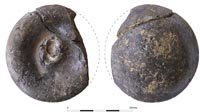 The Surrey County Archaeological Unit (SCAU), based at Surrey History Centre in Woking, has been established for over 20 years. Our involvement in archaeological projects can take the form of advice or consultancy services, fieldwork and post-excavation work. We carry out a range of professional services for a variety of clients, from developers undertaking archaeological work as part of the planning process to national heritage organisations carrying out research projects. The archaeological unit and our highly skilled staff bring a wealth of experience and knowledge to a rich variety of archaeological projects.
The Surrey County Archaeological Unit (SCAU), based at Surrey History Centre in Woking, has been established for over 20 years. Our involvement in archaeological projects can take the form of advice or consultancy services, fieldwork and post-excavation work. We carry out a range of professional services for a variety of clients, from developers undertaking archaeological work as part of the planning process to national heritage organisations carrying out research projects. The archaeological unit and our highly skilled staff bring a wealth of experience and knowledge to a rich variety of archaeological projects.
 One recent project in Surrey, the excavation of an early medieval cemetery, yielded an uncommon find in the form of a glass linen smoother used in the finishing and laundering of textiles and garments. The smoother is dome-shaped on one surface and slightly flattened and countersunk on the reverse side. Within this countersunk area is a characteristic 'blob' of glass where the smoother was separated from the maker's rod (see photograph). The relatively small number of similar linen smoothers found during previous excavations usually range from 6.5cm to 8.5cm in diameter; this Surrey example fits nicely within this range, measuring 70mm in diameter with a maximum height of 35mm. At this size the smoother would fit comfortably within a person's hand enabling them to use the object cold in order to press, smooth or polish damp linen. This object was recovered from a single grave and had been deliberately placed on the deceased's lower torso during burial, where it would have been in direct contact with the clothing or shroud.
One recent project in Surrey, the excavation of an early medieval cemetery, yielded an uncommon find in the form of a glass linen smoother used in the finishing and laundering of textiles and garments. The smoother is dome-shaped on one surface and slightly flattened and countersunk on the reverse side. Within this countersunk area is a characteristic 'blob' of glass where the smoother was separated from the maker's rod (see photograph). The relatively small number of similar linen smoothers found during previous excavations usually range from 6.5cm to 8.5cm in diameter; this Surrey example fits nicely within this range, measuring 70mm in diameter with a maximum height of 35mm. At this size the smoother would fit comfortably within a person's hand enabling them to use the object cold in order to press, smooth or polish damp linen. This object was recovered from a single grave and had been deliberately placed on the deceased's lower torso during burial, where it would have been in direct contact with the clothing or shroud.
 Glass smoothers of this type have been found in on sites in Britain dating from the 8th century, and examples are known from female graves throughout the Viking region, including Anglo-Scandinavian York and Winchester. The post-excavation analysis stage is still underway, although it is likely that this object is also from a female grave. Radiocarbon dates have yet to be undertaken but, based on a range of other evidence, this burial is probably of 10th – 13th century date.
Glass smoothers of this type have been found in on sites in Britain dating from the 8th century, and examples are known from female graves throughout the Viking region, including Anglo-Scandinavian York and Winchester. The post-excavation analysis stage is still underway, although it is likely that this object is also from a female grave. Radiocarbon dates have yet to be undertaken but, based on a range of other evidence, this burial is probably of 10th – 13th century date.
Linen smoothers, also known as 'slickers', 'sleekstones', 'slickenstones' and 'calendar', often occur alongside other objects relating to textiles. Although this is an isolated find within this particular grave, two further individuals were buried with single spindle whorls (used for spinning). In all three of these cases the objects concerned may have been deliberately included as personal possessions, keepsakes, protective amulets or symbols of the home.
Images:
- Glass linen smoother
- The linen smoother in-situ within the grave
- A member of the SCAU team during the excavation

